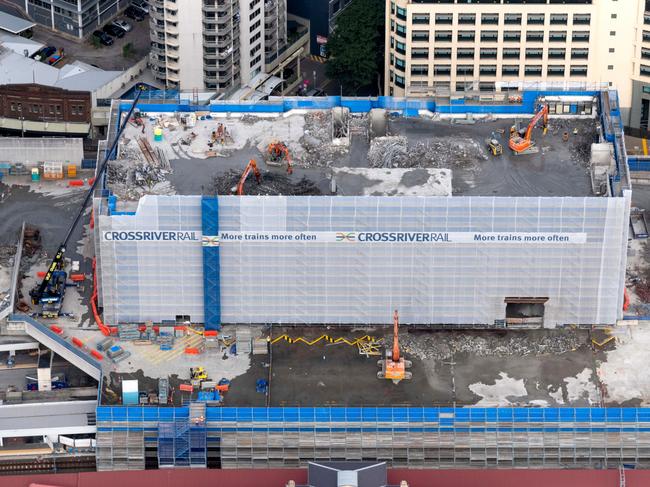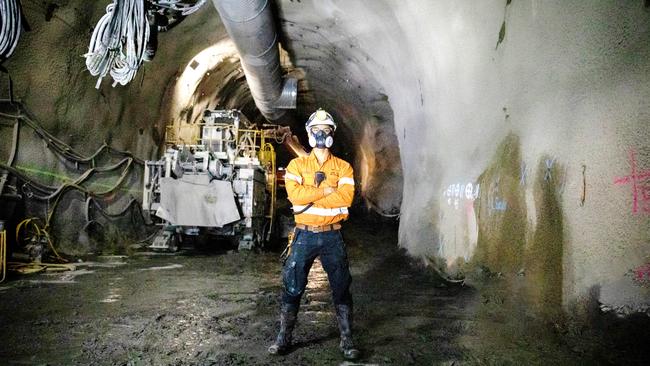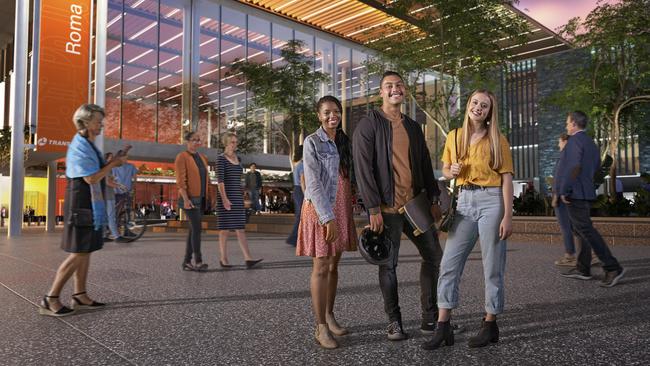Inside the first tunnel to unlock CBD as part of Cross River Rail project
Once home to Brisbane’s ugliest building, the Roma St transit centre is set to be transformed into the city’s Grand Central Station. See the latest progress on the $5.4 billion Cross River Rail project behind the site walls.
A MASSIVE swath of land around Roma St will be transformed with the demolition of the old train station towers and its replacement with what has been dubbed Brisbane’s Grand Central Station.
The first spoil from the $5.4b underground tunnelling has been bored from under Roma St in the past week, the creating access for what will become a 5.9km twin train tunnel.
The Cross River Rail Delivery Authority (CRRDA) have released the first photos from inside the access tunnel, where a massive road header machine is boring its way through some of the toughest rock under Brisbane – Neranleigh Fernvale stone.
How SEQ’s transport systems are about to be transformed
How Cross River Rail will change our city forever
How Cross River Rail will change peak hour commutes

The 115 tonne, 22m long road header can grind out 50 tonnes of rock an hour, boring out the cavern 18m below ground that will hold the twin underground platforms.
But it is above ground that will first catch the eye, with a huge 32ha of land to be redeveloped around the new station.
The hunt is on for the best ideas and tenants to move into the area, with the CRRDA in talks with potential developers to see what they can offer to transform the area on the CBD’s western edge between Countess Street, Roma Street, Albert Street, College Road and Parkland Boulevard as well as State Government land between Roma and Makerston and May streets.
The Courier-Mail, in conjunction with the Cross River Rail Delivery Authority, is presenting a series looking at the project and what it will bring to the state.

CRRDA tunnels, stations and development project director Jeremy Kruger said the Roma Street Transit centre building – touted as one of Brisbane’s least loved buildings before demolition started – would make way for an interchange that would include the underground connected to the rest of the rail network and Airtrain as well as buses, long distance trains and the new Brisbane Metro.
The area surrounding the new underground station – which is projected to handle 46,000 people each weekday by 2036 – is a blank canvas that the CRRDA was looking for exciting ideas to develop.
“There’s a lot of land there that provides a fantastic opportunity for Brisbane to really develop what you could call the western gateway to the CBD and turn it into a really impressive precinct,” Mr Kruger said.
“Whether it is Brisbane Live, commercial, retail, leisure, mixed use it is an exciting site half way between Suncorp Stadium and the CBD.
“With the demolition with the transit centre that runs the length of Roma St, we are creating a blank canvas.”
“It’s a once in a lifetime opportunity and we want to make sure we get it right.”
More than 7700 people will work on Cross River Rail over the five years of construction, with 400 local suppliers signed up and more than 160 apprentice and traineeship positions filled of 450 to be created.
Cross River Rail is a 10.2km rail line from Dutton Park to Bowen Hills, which includes 5.9km of twin tunnels under the Brisbane River and Brisbane CBD.
Work has begun on the project’s four new underground stations at Boggo Road, Woolloongabba, Albert Street and Roma Street.

By introducing another river crossing, Brisbane’s rail network can have more trains more often while the underground means less of the CBD is given over to rail tracks, and stations can sit in the city centre. Its backers say a better public transport system will remove thousands of cars from roads.
“Cross River Rail is not only changing the face of southeast Queensland forever, it’s changing the lives of thousands of Queenslanders during construction,” State Development Minister Kate Jones said.
“So far, we’ve had close to 150 apprentices and trainees already gain on-the-job skills and we are less than 12 months into a five year construction project.
“They’re cutting their teeth on Queensland’s most transformational infrastructure project in the heart of the city – a pretty good way to kick start your career.
“Through our week-long campaign with the Sunday Mail and The Courier-Mail, you’ll meet many of the workers who are making this project a reality.
“It’s remarkable to think that our children and our grandchildren will look back at the photos of workers on our sites today and marvel at the vision and achievement of building Brisbane’s first underground rail line.
“Investment in construction projects like Cross River Rail supports jobs and is crucial to Queensland’s economic recovery in a post-COVID-19 world.
“Each and every day throughout this pandemic, this project is pumping more than $4 million into our local economy.
“It’s also keeping more than 2000 workers employed and to date, more than 400 Queensland subcontractors and suppliers have won contracts on Cross River Rail.
“Projects like Cross River Rail are more important than ever before.”
To find out more about the benefits of the project, engage with us on Facebook or online via crossriverrail.qld.gov.au
